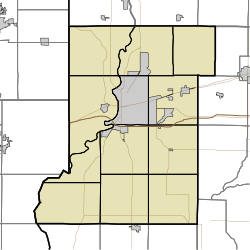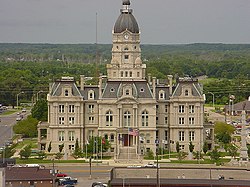| Vigo County Courthouse | |
|---|---|
 | |
| General information | |
| Architectural style | Second Empire |
| Location | 33 So.3rd St, Terre Haute, Indiana, United States |
| Coordinates | 39°27′57″N87°24′52″W / 39.46583°N 87.41444°W |
| Elevation | 506 feet above sea level [1] |
| Construction started | August 1884 |
| Completed | 1888 |
| Inaugurated | June 7, 1888 |
| Cost | $443,000 at original completion |
| Owner | Vigo County, Indiana |
| Height | 284 feet |
| Dimensions | |
| Diameter | 226 feet (NS) and 277 feet (EW) |
| Design and construction | |
| Architect | Samuel Hannaford |
Vigo County Courthouse | |
| Area | 74,515 square feet |
| NRHP reference No. | 83000160 [2] |
| Added to NRHP | June 30, 1983 |
| Main contractor | Terre Haute Stone Co. |
The Vigo County Courthouse is a courthouse in Terre Haute, Indiana. The seat of government for Vigo County, the courthouse was placed on the National Register of Historic Places in 1983.













